Rescatux is a Debian GNU/Linux based live cd aimed at GNU/Linux and Microsoft Windows rescue tasks thanks to its graphical wizard named Rescapp.
Rescatux 0.73 stable version has been just released is available for you to download.
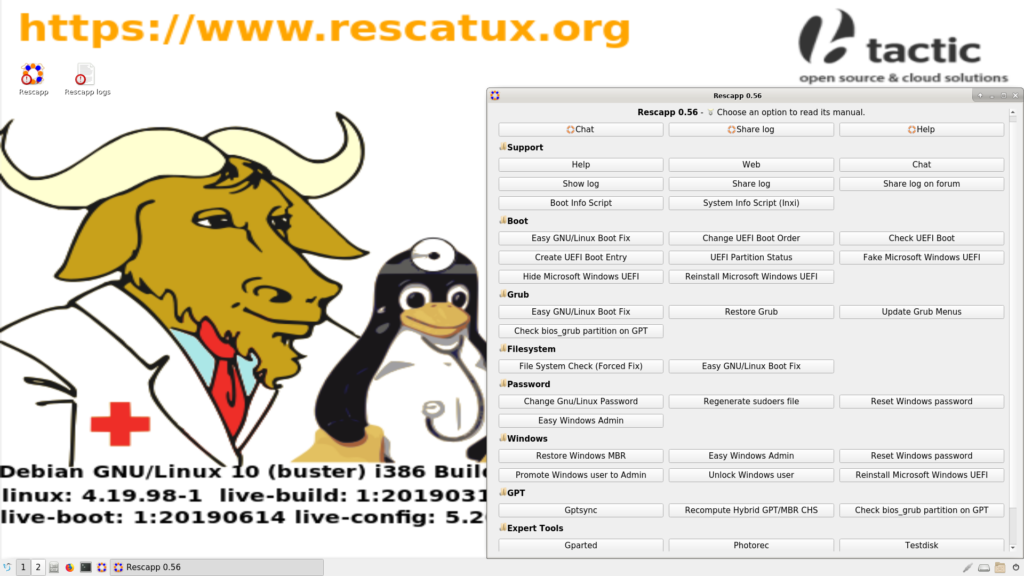
Download
| Rescatux 0.73 ISO (Torrent) (691 MB) | ISO & Source code (Torrent) (2.14 GB) | (Git Source code) |
How to use it in real life
- USB DEVICE: Please use Etcher (or dd carefully if you are an expert) to flash the iso to your usb device (Warning: The complete usb device is erased). Other methods based on external tools that put many ISOs into a single usb are discouraged and not supported because it’s not easy that the resultant USB will support all the as-is Rescatux supported systems.
- CDROM or DVDROM: Burn the iso with k3b, brasero, nero burning rom, or your favourite burning tool (it fits under 700 MiB).
Checksums
Rescatux 0.73 checksumsSupported systems
| Secure Boot | BIOS/EFI platform | Kernel Arch | Boot? |
|---|---|---|---|
| Secure Boot | BIOS/EFI platform | Kernel Arch | Boot? |
| Secure Boot | BIOS/EFI platform | Kernel Arch | Boot? |
Hands On Video
You can watch the Rescatux 0.73 hands on video where you will find a mini tutorial on how to use Rescatux 0.73. Easy GNU/Linux Boot Fix option is featured.
Main changes
The last Rescatux stable version was released on October 2012. That’s about eight years ago.
Many changes have happened to Rescatux since then. UEFI options which became mainstream at 2015 have been added. Secure Boot support has been added. Rescapp is now its own program.
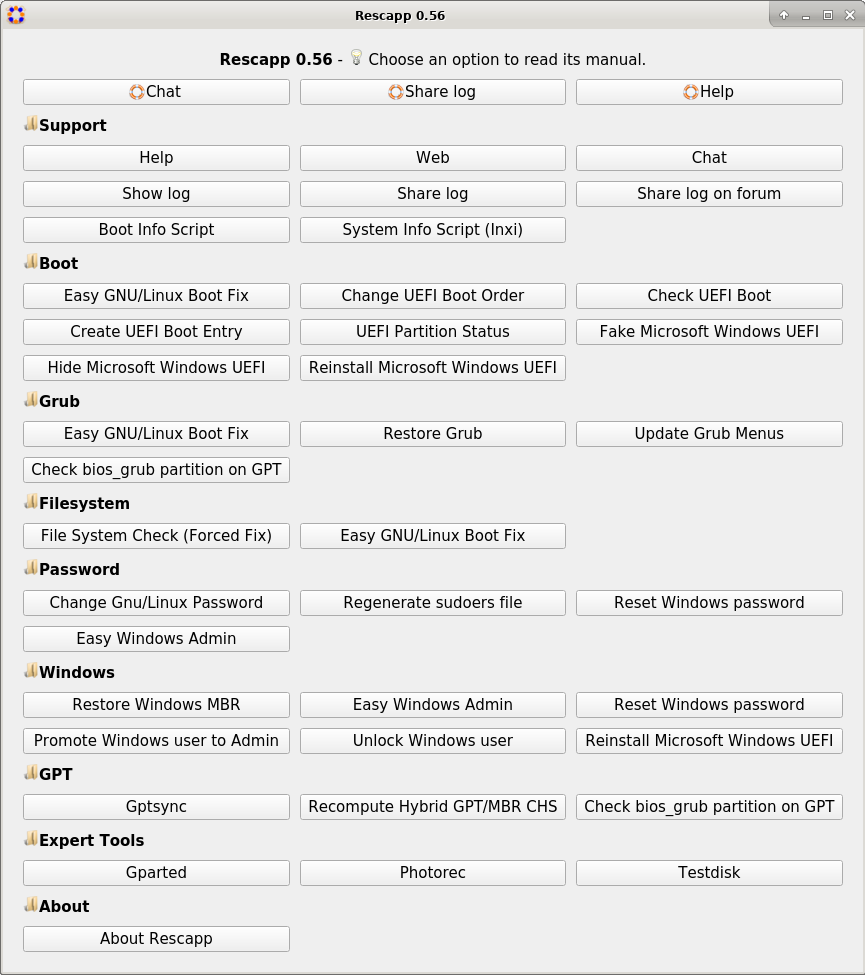
Rescapp had some serious usability flaws that have been fixed. When you run an option you never knew if it was working ok. Now you have an status for the option.
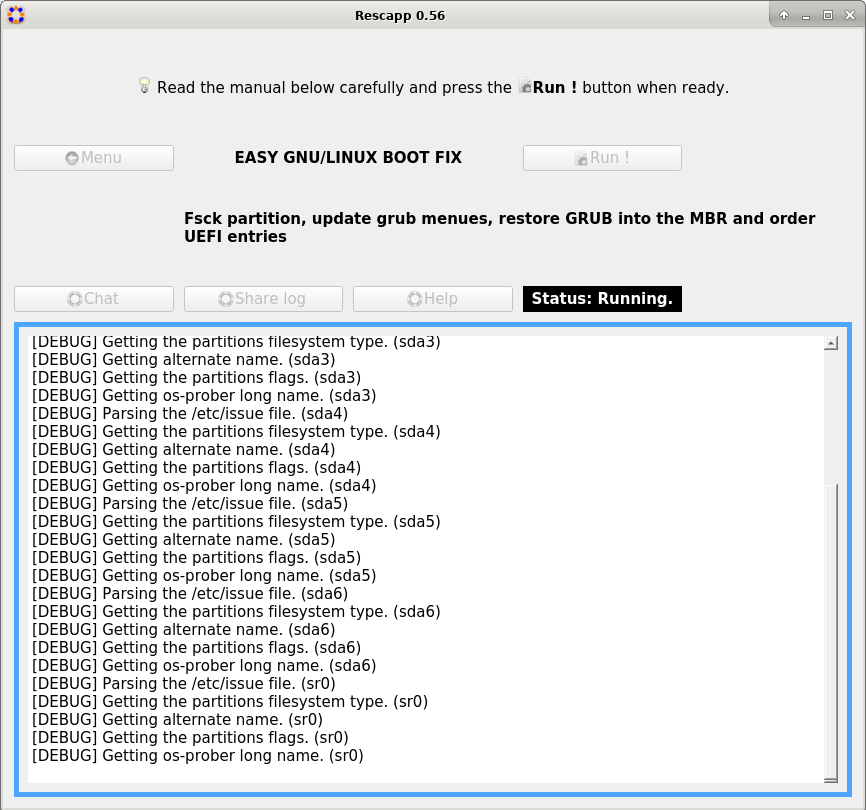
Finally the complete nightmare of pop-ups that were shown when an option is run have been replaced by nice coloured scrolling messages.
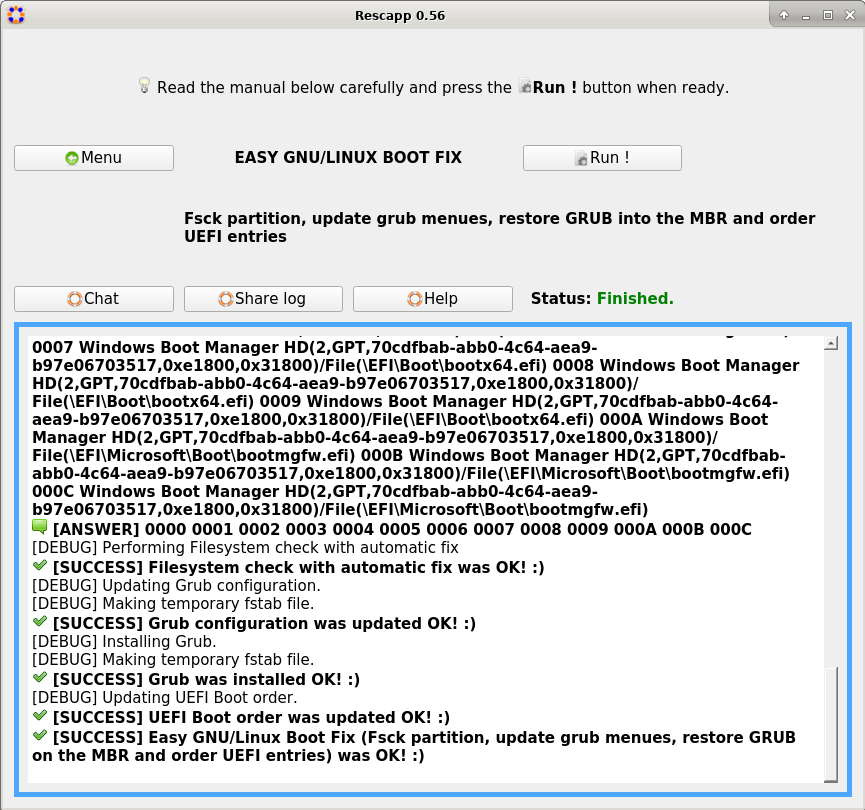
One of the best improvement has been done recently. Rescapp has been improved so that every option is properly documented (as well as a non native English speaker can write).
Not only every question explains all the steps that it performs and the questions they are going to make but some scenarios are explained so that you can understand what’s the most suitable scenario when to use the option.
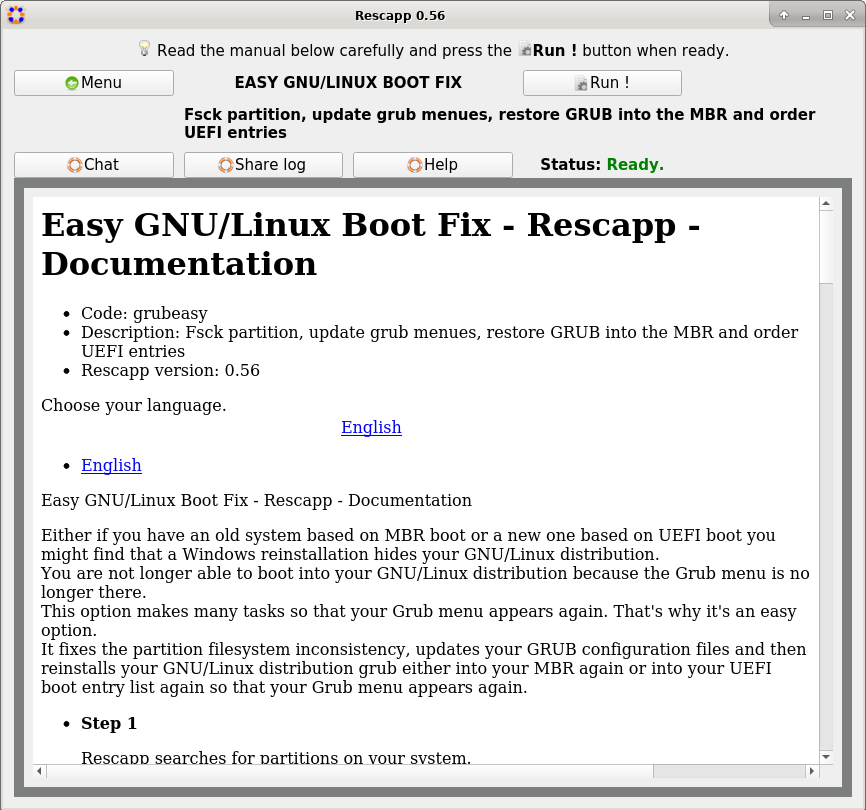
Features
Rescatux 0.73 supports booting from UEFI Secure Boot and traditional BIOS. Both amd64 and 686 systems are supported.
Rescatux includes Rescapp, a graphical rescue tool that will assist users to regain access to a computer that has become non-bootable among many other features.
GNU/Linux options
- Change Gnu/Linux Password : Change a user’s password
- File System Check (Forced Fix) : File System Check (Forced Fix)
- Easy GNU/Linux Boot Fix : Fsck partition, update grub menues, restore GRUB into the MBR and order UEFI entries
- Restore Grub : Restore GRUB into the MBR
- Regenerate sudoers file : Define a new sudoers file
- Update Grub Menus : Update GRUB Configuration File
UEFI Boot specific options
- UEFI Partition Status : Check UEFI partition status
- Check UEFI Boot : Check if Rescatux has boot in UEFI mode
- Create UEFI Boot Entry : Create a new UEFI Boot entry out of your EFI files
- Change UEFI Boot Order : Change UEFI Boot order
- Reinstall Microsoft Windows UEFI : Reinstall Microsoft Windows UEFI boot entries
- Fake Microsoft Windows UEFI : Fake Microsoft Windows UEFI boot entry
- Hide Microsoft Windows UEFI : Hide Microsoft Windows UEFI boot entry and define default fallback one.
Windows password and role related options
- Easy Windows Admin : Promote to Admin, Reset Windows (NT,200x,XP,Vista,Seven) password and unlock user
- Reset Windows password : Reset Windows (NT,200x,XP,Vista,Seven,10) password
- Promote Windows user to Admin : Promote Windows (NT,200x,XP,Vista,Seven,10) user to Administrator
- Unlock Windows user : Unlock Windows (NT,200x,XP,Vista,Seven,10) user
Other options
- Boot Info Script : Boot Information Script
- Check bios_grub partition on GPT : Check if there is a bios_grub partition on a GPT disk
- Gptsync : Create an hybrid MBR inside a GPT partition (Gptsync)
- Recompute Hybrid GPT/MBR CHS : Recompute CHS values on an hybrid GPT/MBR partitiont table
- Restore Windows MBR : Restore generic MBR code so that Windows boots again
- System Info Script (Inxi) : System Info Script (Inxi)
Support features
- Chat : Get online human help (chat)
- Help : Help on using Rescapp
- Share log : Share Rescatux logs. It generates a pastebin in paste.debian.net and shows it to you so that you can copy and paste the url in the chat.
- Share log on forum : Share Rescatux logs on a forum. It generates a temporary file ready to copy and paste on your favourite forum (ubuntuforums.org and others).
- Show log : Show Rescatux logs so that you can ask help and supporters can know what happens when you run Rescatux options
- Web : Access online Rescatux website
External tools
- Gparted : GParted is a free partition editor for graphically managing your disk partitions.
- Testdisk : Testdisk is a text wizard drive program for rescuing disks, partitions, and files.
- Photorec : Photorec is a text wizard drive program for rescuing files. Despite its name it recovers much more files than photo files.
What’s new on Rescatux (since Rescatux 0.72-beta8)
- Grub menu recovers Auto entry.
- Grub menu boots into Auto entry in 60 seconds.
- Built source code now includes rescapp and chntpw packages.
- Stable version.
What’s new on Rescapp (since Rescatux 0.72-beta8)
- Rest of the plugins documentation has been updated to match 2019 gui.
- Removed tooltips from main menu.
- Added initial useful explanations on options documentation.
- Disable action buttons when an option is run.
- UEFI options now show the final user when the backup of EFI directory fails.
- README reorganisation.
- Stable version.
Known bugs
- Graphical interface is not shown if you have newest Amd videocards from 2020
- Encrypted partitions need to open manually via the CLI (if they are ever needed in order to rescue your system). That’s not strictly a bug but a non-fullfilled request for enhacement (RFE).
Feedback and support
Rescatux is designed in such a way that you can use it on your own offline by just reading its help. Although the documentation could be much better written.
I am unable to keep a proper forum up right now. So if you have any question or suggestion I recommend you to open a new issue in the Rescapp issue tracker. Please before opening a new issue check if your problem was already was asked and solved in the Rescapp issue tracker question labeled issues.
You can also ask for help on the integrated Rescatux irc channel. Hopefully someone will be online.
Thank you
- cjg67 for his work on improving Rescapp documentation grammar.
- cjg67 for his incredible work on packaging Rescapp to Arch and Fedora. (BTW one of these days I need to add a page dedicated to Rescapp where I feature those packages.)
- eris23 from linuxtracker community who has uploaded many times the Rescatux isos to the torrent site.
- Many anonymous users which create new bugs at rescapp issues page.
- Many anonymous users which came back to the Rescatux chat after trying our given advice in the chat
- Alf Gaida (agaida) on the many times he has helped me on integrating LXQt to Rescatux.
- bTactic, for helping Rescatux with their Zimbra based email service and their hosting.
Interview
- Q: Tell us about Rescatux. Where, how and why?
- A: Before Grub2 was the norm there was Grub which was able to edit minimally your system (install grub on the mbr). I develop a GUI around it named Super Grub Disk, later on I improved it by modifying its source code. But then Grub2 started to be used by default in many distributions. Super Grub2 Disk was born, a GUI around Grub2 but, guess what, it couldn’t install grub on the mbr. So a live cd was needed and I started to tinker with Rescatux around 2010.
- Q: For those people that still do not know Rescatux, can you please explain what Rescatux is?
- A: It’s a Debian GNU/Linux based live cd aimed at rescue tasks. It features Rescapp a graphical wizard for helping to recover your system.
- Q: Why did you choose the Rescatux name?
- A: In Spanish it might mean Rescate Linux. And in English Rescue a Tux computer. I also wanted one single name (contrary to the three words from Super Grub2 Disk).
- Q: Who’s in charge of the development?
- A: Most of the development is done by me, adrian15. Many people have helped all along these almost ten years.
- Q: What’s the Rescatux target audience?
- A: GNU/Linux newbies such as Ubuntu users in 2015 and MX Linux users in 2020. It’s also targeted to repair technicians and, of course, distro hoppers.
- Q: What are the main difficulties on developing Rescatux?
- A1: Lack of time.
- A2: When I’m able to build on Debian 9, then Debian 10 appears and I have to rethink all of it.
- A3: live-build, one of the Debian tools for making live cds was not as good as I needed it to be and I needed to improve it, then push back the changes to upstream.
- A4: Getting useful feedback from people who uses Rescatux (even having an integrated chat) is difficult.
- A5: Nobody has steped in to add CI/CD and check if Rescatux always fixes the same problems. We would need something similar to what ReactOS and Tails do on their projects.
- A6: Lack of contributors. This is not a tool where, as a developer, you can learn useful skills for your everyday work unless you are GNU/Linux repair technician.
- A7: I prefer QT but Gparted, Firefox and other projects are based on GTK and make Rescatux iso slightly bigger.
- A8: UEFI, Secure Boot and what not. We live in a time where old BIOS systems and new UEFI systems are available. Both need to be supported and also Secure Boot. And trying to test Secure Boot in a virtual machine is not easy. You cannot use Virtualbox but you need to setup and user KVM/Qemu in special ways. And many UEFI firmwares are not very well programmed.
- Q: What are the main collaborations or help you received on Rescatux ?
- A: The most recent contributor is cjg67 which helped a lot on improving written English in Rescapp. It’s also nice that many Linux magazines write articles about it and even record DVDs with Rescatux in them.
- Q: Can you tell us anything about the Rescatux future?
- A: Rescapp, the main Rescatux program is stable. It might need some options reorganisation (feedback is welcomed) or some documentation rewriting. But it is stable. My mid term goal on Rescatux is bringing back my work on live-boot, live-build, liveid, chntpw (which I will fork), and rescapp back to Debian. If one such goal is achieved one could be able to install rescapp on a Debian live cd thanks to the apt-get command.
Pinging back the Press
- ALL: How to test the iso. What really piss me off is those people which create a new empty virtual machine and start up Rescatux cdrom without any installed operating system in their virtual machine. This might be ok for your regular GNU/Linux distribution live cd but not for Rescatux. You are not going to enjoy how Rescapp recover your boot and al. Please setup a dual boot (e.g. Windows 10 and Ubuntu 18.04) environment and try to play with Rescapp boot options. Forget your GNU/Linux password on purpose. If you try the EFI mode in Virtualbox remember that you never have to power off the machine. Just reboot it from inside your installation or save the vm state and later on resume it. Else you might find out that you lose the your recently installed UEFI menu. Finally if you are expert enough try to setup a KVM/Qemu with actual Secure Boot instead.
- ALL: More than Rescapp. You might be tempted to skip the boot menues and the Rescatux startup wizard in your explanations because the useful thing is Rescapp. Don’t miss the opportunity to talk about it because it ensures to be shown in the middle of two screens and allows Rescatux to be accessed via VNC. Change your keyboard and so on.
- Distrowatch: Thank you for helping me to bring Rescatux and Super Grub2 Disk to your audience. Rescatux is targeted at newbie Ubuntu users (which I guess that nowadays are the newbie MX Linux users), repair technicians and distro hoppers. Hopefully one day I can find time to develop a new standard based on rss so that you can keep track of new distribution releases in a semi-automated way. BTW if you come from Distrowatch weekly where this announcement is featured your feedback is welcomed in the DW comments. I’ll try to participate and solve doubts if anyone has them.
- Linux Magazine: Thank you for making your 167 number Fast Help article free for everyone to read. Ferdinand Thommes (the article writer) came into the Rescatux irc channel back in the day for having updated feedback from us. It was nice meeting him.
- Linux Magazine: Your 228 issue had a DVD with Super Grub2 Disk. The DVD label mockup should have had the version (2.04s1 or whatever) in addition to Super Grub2. E.g. Super Grub2 2.04s1. Anyways I’m grateful and at the same time amazed because this is about 17 MB burned into a 4.3 GiB DVD side !!! Once I manage to add Secure Boot support to Super Grub2 Disk I need to build an iso that features both SG2D and Rescatux so that not so much space is wasted.
- Destination Linux: I watched your DL138 episode (48 minute). I liked Noah explanation on saying that when Grub does not boot it it’s usually a synthom that something else is bad. Hopefully one day you cover Rescatux release.
- Carey Holzman: I enjoy watching you repairing computers. One of the last episodes I saw was LIVE – Tech-Vets show #150 where I learnt how the new worldwide state was being dealt in the U.S.A. and among computer repair men. I also enjoyed your rant on your wife employer not giving her a laptop and a separate internet connection. I guess Parted Magic (which it’s a paying product) is more suited for many of your tasks but it would be nice you could try Rescatux and give me some live feedback that I can use back to improve Rescatux usability or functionality. It’s usually hard for me to receive useful feedback. Usually people are in a hurry to use Rescatux and if it doesn’t work they switch to another solution.
- MuyLinux: I sent you an email many years ago telling you that Rescatux was going to be released as an stable version very soon. It seems I lied to you XD. You have invited me many times to write an article about Rescatux (which I have declined because I preferred to work on improving Rescatux) but I think I will leave it to you. After all if I write it myself I might lose the opportunity on grasping how Rescatux is perceived by someone other than me.
- Barrapunto: Hi kandinski! Hopefully one day you can surprise all of us and reopen the site. I miss writing in my own bitacora.
- Meneame (not the site owners but its community):
- Message for the one who brings potatoes: This is a proud GNU/Linux distribution. I should write it down more often. Hopefully the GNU and Tux background makes you happy enough to forgive me not writing GNU/Linux after everytime I write Rescatux.
- I have thought on bringing back my barrapunto bitacora back as meneame articles but I’m not quite convinced. Any replacement for Barrapunto that you recommend me? Thank you.
- If you are commenting on a new Rescatux article on meneame make sure to ask your doubts there. I might be around and reply to them 😉 .
- Linux Format: I enjoyed your Rescue distros roundup on LXF209 where Rescatux won. On LXF250 you mentioned that Rescatux was not maintained and that’s why it was not considered. I was disappointed till I checked that at that time (June 2019) latest Rescatux distribution release was from December 2017. Yes, I had done some internal builds from November 2018 where I tried once again to use LXQT but I hadn’t made it public, so, it didn’t exist. Funny enough on May 2019 (probably after the article was written) Rescatux 0.71-beta7 was released. Anyways Rescatux being perceived as disappeared encouraged me to work hard on it so that we finally had an stable release. So thank you!
- Linux Format: Some notes on updating Rescue distros roundup from LXF209 to match Rescatux 0.73:
- Tools repository: I removed the external Boot Repair tool although it has many tools. [No change.] (4/5)
- Customisability: No one has shown interest in being able to build its own custom Rescatux so I haven’t worked on it. [No change.] (2/5)
- User experience: Thanks to the new status frame where you can see what Rescapp does the usability is even better than before. [No change.] (5/5)
- Support & rescue docs: The current documentation and videos on the website are aging a bit but a lot of work has been put into generating a proper inline documentation that you can read from Rescatux itself (without an internet connection). [No change.] (5/5)
- Security features: Current iso also has GPGV and shred but I didn’t put them on purpose. Security is not a priority. You can drop one point if you want to. [-1] (1/5)
- Custom tools and UIs: Yeah, now Rescatux not only has Rescapp but a Rescatux startup wizard which assists you to change display resolution, locale, vnc or keyboard layout. (6/5)… I mean… [No change.] (5/5) 😉 .
- Healing capabilities: Boot Repair tool is no longer there but many UEFI options have been added. [No change.] (4/5)
- The verdict [No change.] (5/5)
- Linux Format: Tux with fingers should not be! you say. Not only I managed to show a penguin that almost drowned but I also made it more human by giving him fingers. I only will say that it made sense when I first thought about it XD. Rescatux background no longer features the humanoid-drowning-tux but a GNU and a Linux images. Website images, to your concern, won’t be updated in the short term, so you will see the humanoid-drowning-tux once in a while 😉 .
- Linux Format: I checked the LXF259 DVD iso and you have a pretty nice system based on Grub. It supports booting from both BIOS and UEFI (IA32 and AMD64) systems. Congratulations! Super Grub2 Disk is less than 17 MB in size. I want to release an special ‘script’ release in the future so that you can just configfile its cfg which it’s the right way of using it.
- Linux Format: On the LXF259 DVD iso you feature Rescatux. It’s nice how you can use your parser (aimed at live-build disks) and create a Rescatux boot entry. Can you please improve it by supporting loopback.cfg (and thus liveid)?
menuentry "Rescatux X.YY" {
iso_path=/Rescatux/rescatux-0.72-beta4.iso
export iso_path
#search --set=root --file $iso_path
loopback loop $iso_path
root=(loop)
configfile /boot/grub/loopback.cfg
loopback --delete loop
}Forward pinging
- MX Linux: I know you have a tool named MX Boot Repair. It’s not easy to predict when I’ll be able to add Rescapp to Debian properly. It would be nice if you could evaluate Rescapp as a replacement for your MX Boot Repair. What features you are missing from it. And, maybe, if you need an special start switch so that only two or three options are shown to your live cd users. You can find Debian Buster based repo in Rescatux repo and you can also use the quick script on Non-free Rescatux documentation. And make sure the user which runs rescapp can sudo any command he wants to (as it usually happens in Live CDs).
What about the future
My plans on future development :
- Unspecified pause
- Soften Super Grub2 Disk AFD prank
- Working on adding Secure Boot to Super Grub2 Disk
- Maybe improving Rescapp documentation, release new stable Rescapp and Rescatux releases
- Probably also releasing a Super Grub2 Disk version based on GNU/GRUB 2.06 version
- Maybe work on a new Rescatux webpage
- Update Rescatux images to remove Tux with fingers so that Linux Format magazine guys stop complaining (and because we have better background and logo designs right now 😉 )
- Push live-boot liveid improvements back to Debian
- Push live-build Rescatux improvements back to Debian
- Work on Super Grub2 Disk script release so that Linux Format Guys can include a working version of Super Grub2 Disk on their multiarch enabled DVDs
- Getting back Rescatux improvements on live-build and live-boot to upstream (Debian)
- Fork chntpw properly into another name
- Make chntpw fork a proper Debian package
- Make rescapp non arch dependent (all package in Debian)
- Make rescapp a proper Debian package
- Release a Rescatux version based on Debian 11 (Bullseye)
- Trying to push a graphical rescue flavour into Debian itself almost (but not better than) as good as Rescatux.
- Release a Super Grub2 Disk and Rescatux all-in-one iso
Rescatux 0.73 checksums MD5SUMS: 89953a483807719997f4e9cb86a959c6 source-code/rescatux-0.73-main-rescatux-repo-c26e8c77d41365b6392a0f0e4013e24a4cc29b58.tar.gz e04bbcdfd0571ea56eb334cb35cc739e source-code/rescatux-0.73-source.live.tar 8f2bf5d45e54aca3bc9758523de61885 source-code/rescatux-0.73-live-build-rescatux-0.73rc1-tmp1.tar.gz abd8f12f2b167d4bf748a36656b29cbb source-code/rescatux-0.73-source.debian.tar 8db2eb6fd8c03cc999bb4d37a7fcf629 source-code/rescatux-0.73-chntpw-debian-ng-1.02.tar.gz b4e6c47d05d1e2d050a910ecf8cfcd0f source-code/rescatux-0.73-live-boot-rescatux-0.75b5-tmp1.tar.gz 56de73dcfff577bd95fe77589275808f source-code/rescatux-0.73-rescapp-v0.56-debian.tar.gz 21f7947934171719557db4d093a3320c rescatux-0.73.packages 7487260e9c36a6ba63df7d736d79c129 rescatux-0.73_build.log 03be111b36e572bf4cd686af964573a3 rescatux-0.73.iso f862f0b3e861df6e30333aca25e0aa28 rescatux-0.73.iso.md5 SHA256SUM: 2b5e9f0ab2e766ccc43d72a2705233f2cb47cbe93c532e111554d5d4825a82a3 source-code/rescatux-0.73-main-rescatux-repo-c26e8c77d41365b6392a0f0e4013e24a4cc29b58.tar.gz 3f420c6858ba0d433863eb35a251bd92442d93be18bd5032c3eafc219a8d53c3 source-code/rescatux-0.73-source.live.tar ed019c62d5b5b0da812ebc01c84970ddf3c9c46c0c16f890e52022398572a2bc source-code/rescatux-0.73-live-build-rescatux-0.73rc1-tmp1.tar.gz c53d04534454be5e3b1a5aa525098c0d387c1d906c244a9e1a6c495f4af43aff source-code/rescatux-0.73-source.debian.tar afeafa5dd6e893557fa90b62ac45c2c60edd4ba7194a120d84840856d1bd5a2f source-code/rescatux-0.73-chntpw-debian-ng-1.02.tar.gz 5e2923846914f70b5b22948548ddf6c69f45759aa1c0f4fd22a166e3d94f7624 source-code/rescatux-0.73-live-boot-rescatux-0.75b5-tmp1.tar.gz 06088c8b1a6b13bd7a9de2ec0010440dd68ed3ca3f6583a0daac34b8524eef50 source-code/rescatux-0.73-rescapp-v0.56-debian.tar.gz 79aea59d59c00fda18ef44660aea2b9f55e44f5eabf716a7b67397cf90308a1e rescatux-0.73.packages 74fb0d84002ff66b98de925eec228da0e2dbbdd1c29af7186ecb4bf16c5963c8 rescatux-0.73_build.log 399ce3c8e67ce67592d032c1d41d029c7838e81f65e28a20486d501621f5fcf9 rescatux-0.73.iso c556c87cffc243d8a7c7fba47743d241e1fe905c23a8cf56d98c1d9070d1940c rescatux-0.73.iso.md5 SHA1SUM: 8ff496e6da13393ac2bcbd4b790827170520070f source-code/rescatux-0.73-main-rescatux-repo-c26e8c77d41365b6392a0f0e4013e24a4cc29b58.tar.gz def9e6aacfb74af89df27bf82dfd0d34ab183ad3 source-code/rescatux-0.73-source.live.tar 56f5bf536d0af5e9fdfadfb34371ff776def25ab source-code/rescatux-0.73-live-build-rescatux-0.73rc1-tmp1.tar.gz 7c60fee082bb2eb000a874428f004e7456836d97 source-code/rescatux-0.73-source.debian.tar 0b8ffd15c9982dbd18a18b39411fbd682dbf8424 source-code/rescatux-0.73-chntpw-debian-ng-1.02.tar.gz 9a5841b78d146a44de8c452a0abceb39c49cf235 source-code/rescatux-0.73-live-boot-rescatux-0.75b5-tmp1.tar.gz 73debbc1dedf5e17829d3c890599e2aea3165e7a source-code/rescatux-0.73-rescapp-v0.56-debian.tar.gz 4278b491aa36b57524d2fa0615aa0db580a8d4e8 rescatux-0.73.packages 2412c20db66ee3136c165eb3f5fede2a7cea6d61 rescatux-0.73_build.log 6d0a91300424f08b26ac9d4ad17b5a5517d83ab5 rescatux-0.73.iso 129b8ec3681fb2570fb287659d840e8ddbe52c83 rescatux-0.73.iso.md5
More information
You can find more information in: Rescatux .
Does this program work if the system partition is LVM2? I need to restore/repair grub2.
Debian-live (buster kernel) does not activate lvm2 support and therefore does not work. Is this any better?
Yes, Rescatux supports LVM2.